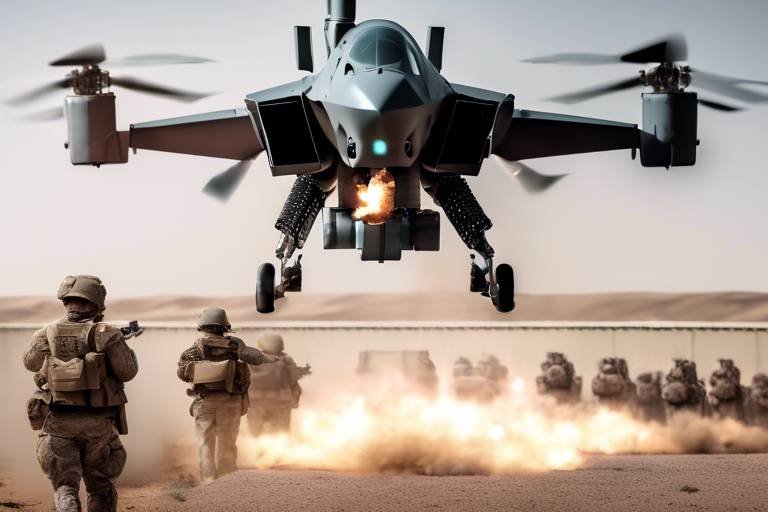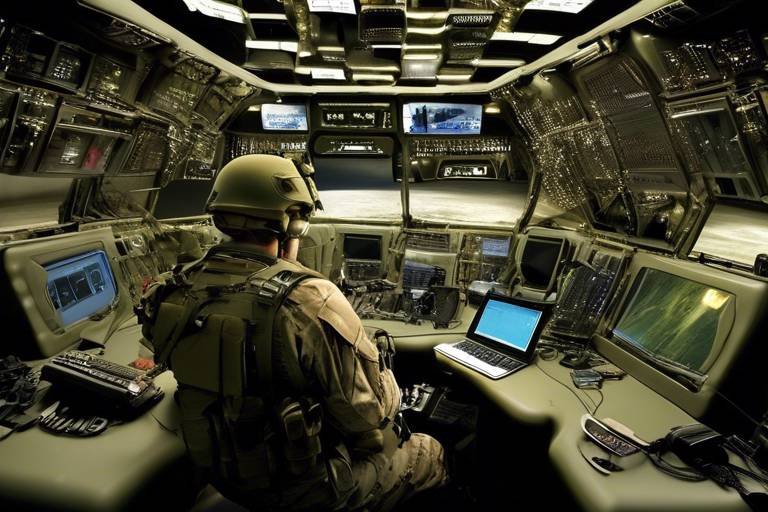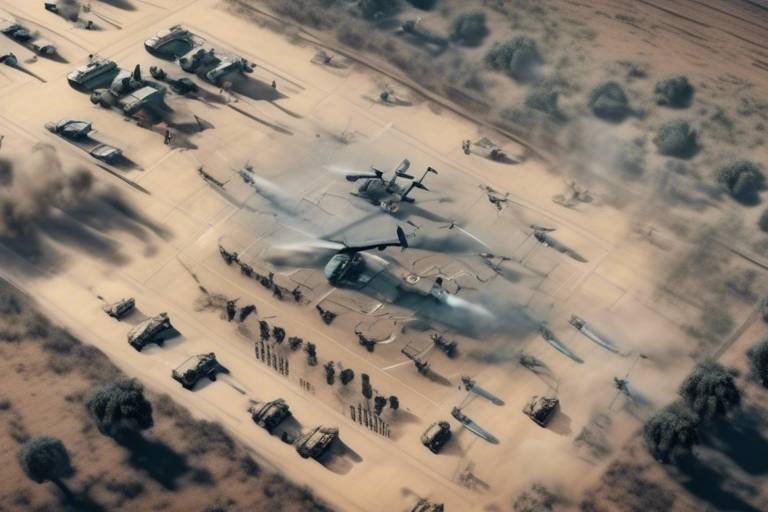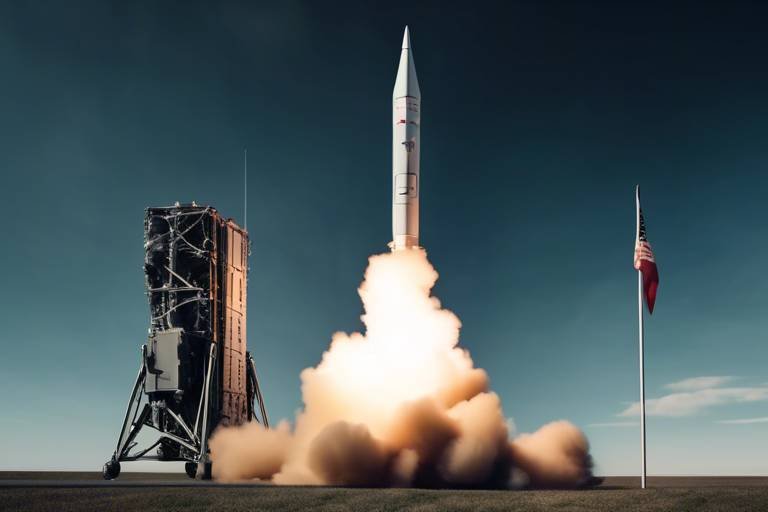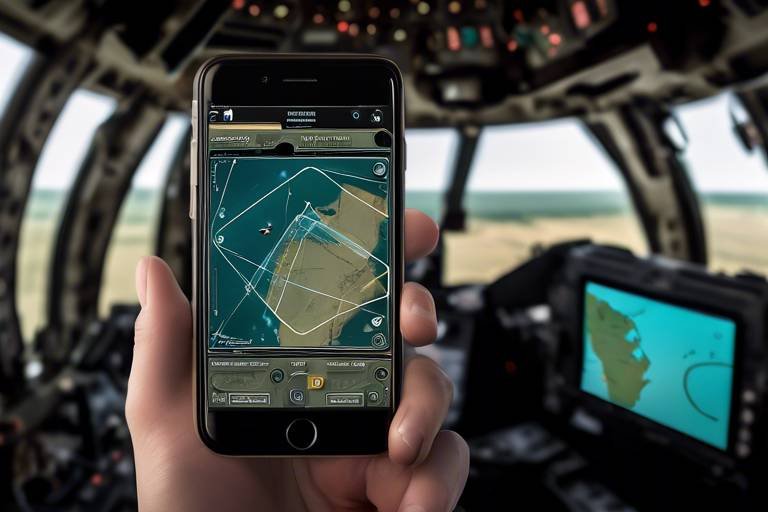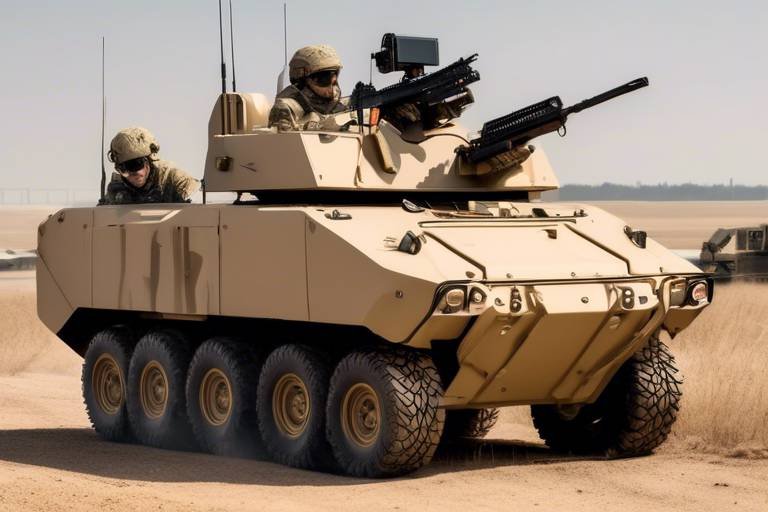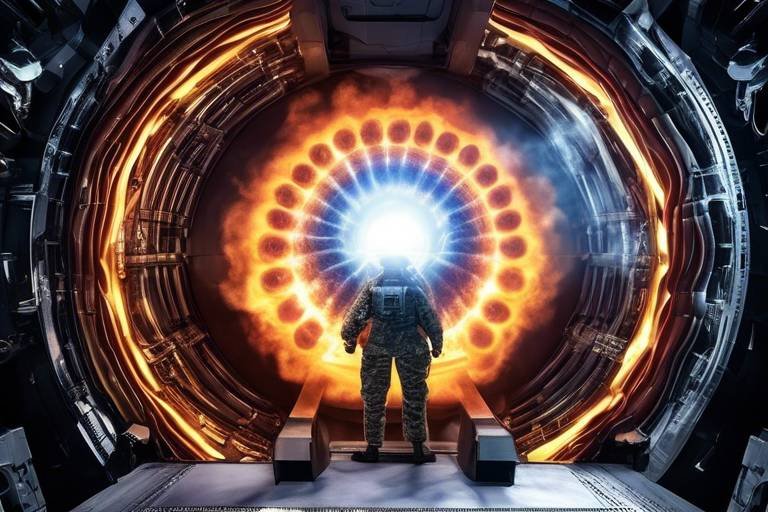The Role of AI in Reducing Collateral Damage in Warfare
In the ever-evolving landscape of modern warfare, the integration of artificial intelligence (AI) is nothing short of revolutionary. As conflicts become increasingly complex, the need to minimize collateral damage—that is, the unintended harm to civilians and non-combatants—has never been more pressing. AI technologies are stepping up to the plate, transforming how military strategies are developed and executed. Imagine a battlefield where decisions are made with pinpoint accuracy, where the risk to innocent lives is dramatically reduced. This is not just a futuristic vision; it is becoming a reality thanks to AI.
At its core, AI enhances the precision of targeting systems, allowing military forces to identify threats while safeguarding civilian populations. This is achieved through sophisticated algorithms that analyze vast amounts of data in real-time. Think of it as having a super-intelligent assistant that can sift through information faster than any human could, providing commanders with actionable insights that help them make informed decisions quickly. The implications for reducing collateral damage are profound, as military operations can be conducted with a level of accuracy that was previously unimaginable.
But how does this actually work on the ground? AI-driven systems utilize a combination of machine learning and computer vision technologies to enhance operational efficiency. They can process images and data collected from drones, satellites, and ground intelligence, allowing for a comprehensive understanding of the battlefield. For instance, if a military operation is underway in a densely populated area, AI can help identify civilian structures and assess the potential risks associated with engaging a target nearby. This capability not only minimizes the risk of collateral damage but also fosters a sense of responsibility among military personnel.
Moreover, the role of AI extends beyond just targeting. It plays a crucial part in data collection and analysis. Effective military operations rely on accurate and timely information. AI systems can gather intelligence from multiple sources, analyze patterns, and predict outcomes, enabling commanders to make strategic decisions that prioritize civilian safety. This real-time decision-making process is vital, especially in dynamic combat scenarios where the situation can change in an instant. Imagine being in a high-stakes game of chess, where every move counts, and having a partner that can calculate the best possible outcomes in milliseconds—this is what AI brings to the table.
However, as we explore the benefits of AI in warfare, we must also confront the ethical considerations that accompany these advancements. The development of autonomous weapons systems raises critical questions about accountability. If a machine makes a decision that leads to unintended harm, who is responsible? Establishing clear lines of accountability is essential to maintaining ethical standards in military operations that utilize AI. The challenge lies in ensuring that these systems are programmed with robust ethical guidelines to prevent catastrophic mistakes.
Public perception plays a significant role in the acceptance of AI technologies in warfare. As military organizations integrate these advanced systems, building trust within the community is paramount. The public must be assured that AI is being used responsibly and that measures are in place to mitigate risks associated with its deployment. Transparency in how AI systems operate and the safeguards in place can help foster this trust.
In conclusion, the role of AI in reducing collateral damage in warfare is a multifaceted issue that encompasses technological innovation, ethical considerations, and public perception. As we move forward, it is crucial to strike a balance between leveraging AI's capabilities and ensuring that the moral implications of its use are thoroughly addressed. The future of warfare may well depend on our ability to harness the power of AI while prioritizing the safety and dignity of all individuals, combatants and non-combatants alike.
- What is collateral damage? Collateral damage refers to unintended harm inflicted on non-combatants during military operations.
- How does AI help reduce collateral damage? AI enhances precision targeting, enabling military forces to identify threats while minimizing risks to civilians.
- What are autonomous weapons systems? Autonomous weapons systems are military technologies that can make decisions without human intervention, raising ethical questions about accountability.
- Why is public perception important in AI warfare? Public trust in AI technologies can influence military policies and their successful integration into combat strategies.

Understanding Collateral Damage
Collateral damage is a term that has become all too familiar in discussions about warfare. It refers to the unintended harm inflicted on non-combatants during military operations. Imagine a scenario where a military strike aims to eliminate a high-value target, yet the explosion inadvertently affects nearby civilians. This tragic outcome highlights the importance of understanding collateral damage, not only for ethical considerations but also for strategic military planning.
As the landscape of warfare evolves, the implications of collateral damage become even more critical. In an era where public opinion can sway military decisions, the need to prioritize civilian safety while achieving military objectives has never been more pressing. The impact of collateral damage extends beyond the immediate physical harm; it can also lead to long-term psychological effects on affected communities, fueling resentment and potentially breeding future conflict.
To grasp the full scope of collateral damage, it’s essential to consider its various dimensions. Here are some key aspects:
- Human Cost: The most immediate consequence is the loss of innocent lives, which is a devastating reality of modern warfare.
- Infrastructure Damage: Strikes can destroy homes, schools, and hospitals, leading to a humanitarian crisis.
- Societal Impact: The aftermath can destabilize entire communities, leading to displacement and increased violence.
Understanding collateral damage is crucial for military planners and strategists. It informs decisions about target selection, weapon systems, and operational tactics. By minimizing collateral damage, military forces can not only achieve their objectives more effectively but also maintain legitimacy and support from the local population and the international community.
In summary, collateral damage is a complex issue that intertwines ethical considerations with military strategy. As technology advances, particularly with the integration of artificial intelligence in warfare, the hope is that these tools will help mitigate the risks associated with collateral damage, leading to more precise and humane military operations.
- What is collateral damage? Collateral damage refers to unintended harm to non-combatants during military operations.
- Why is understanding collateral damage important? It is crucial for ethical considerations and strategic military planning to minimize harm to civilians.
- How can AI help reduce collateral damage? AI technologies can enhance precision in targeting and improve decision-making processes, thus minimizing the risk to civilian populations.

AI Technologies in Warfare
Artificial intelligence (AI) is revolutionizing the landscape of modern warfare by introducing a plethora of technologies that enhance military effectiveness. From machine learning algorithms to computer vision systems, AI is being integrated into various military applications to improve operational efficiency and targeting accuracy. This transformation is not merely a technological upgrade; it represents a paradigm shift in how military strategies are conceived and executed. Imagine a battlefield where decisions are made not just based on human intuition but also on data-driven insights that can predict enemy movements and civilian presence with remarkable accuracy.
At the heart of these advancements are several key AI technologies that are changing the face of warfare:
- Machine Learning: This subset of AI enables systems to learn from data and improve over time. In military applications, machine learning algorithms can analyze vast amounts of intelligence data to identify patterns and predict potential threats.
- Computer Vision: This technology allows machines to interpret and understand visual information from the world. In warfare, computer vision can be used for surveillance, target recognition, and even assessing the damage post-strike.
- Natural Language Processing (NLP): NLP enables machines to understand and respond to human language. This can be particularly useful in analyzing communications and extracting actionable intelligence from intercepted messages.
These technologies work in concert to create a more informed and responsive military environment. For instance, AI-driven systems can process real-time data from drones, satellites, and ground forces, allowing commanders to see the battlefield from multiple perspectives. This capability not only enhances situational awareness but also helps in making decisions that prioritize the safety of non-combatants.
Furthermore, AI technologies facilitate predictive analytics, which can forecast potential conflicts and civilian casualties based on historical data and current intelligence. By analyzing past military operations, AI can identify patterns that lead to collateral damage and suggest alternative strategies that minimize risks to civilians. This proactive approach to warfare is akin to having a crystal ball that helps military leaders foresee and mitigate potential disasters before they occur.
As we delve deeper into the implications of AI in warfare, it's essential to recognize that these technologies are not without their challenges. The integration of AI into military operations raises questions about reliability, ethical considerations, and the potential for misuse. Nevertheless, the benefits of AI, particularly in reducing collateral damage, position it as a critical component of future military strategy.
- What is collateral damage? Collateral damage refers to unintended harm inflicted on non-combatants during military operations.
- How does AI help reduce collateral damage? AI enhances precision in targeting and improves decision-making, allowing military operations to minimize risks to civilian populations.
- What are some AI technologies used in warfare? Key technologies include machine learning, computer vision, and natural language processing.
- Are there ethical concerns with using AI in warfare? Yes, there are significant ethical dilemmas regarding accountability and the potential for unintended consequences.

Precision Targeting Systems
In the modern battlefield, where every second counts and the stakes are incredibly high, have emerged as a game-changer for military operations. These systems, powered by artificial intelligence, are designed to enhance the accuracy of strikes while simultaneously minimizing the risk of collateral damage. Imagine a world where military engagements are not only more effective but also more humane, where the focus is on precision rather than sheer firepower. This is the promise of AI-driven technologies.
At the heart of these precision systems lies the ability to analyze vast amounts of data in real time. By leveraging machine learning algorithms and computer vision, military forces can identify and track targets with remarkable accuracy. For instance, instead of relying on outdated maps and static intelligence, AI systems can pull in data from various sources, including satellite imagery, drone feeds, and ground reports. This integration of information allows commanders to make split-second decisions that can mean the difference between a successful mission and unnecessary civilian casualties.
One of the most significant advantages of precision targeting systems is their ability to operate in complex environments. Traditional targeting methods often struggle in urban settings, where distinguishing between combatants and non-combatants can be incredibly challenging. However, AI technologies can analyze patterns and behaviors, enabling them to differentiate between legitimate threats and innocent civilians. This capability not only enhances operational effectiveness but also aligns with the growing demand for ethical warfare practices.
Moreover, the implementation of these systems is not just about technology; it also involves a profound shift in military strategy. Commanders are now encouraged to adopt a mindset that prioritizes minimizing harm to civilians. This cultural change is crucial as it fosters a more responsible approach to warfare. For example, before a strike is authorized, AI systems can run simulations to assess potential outcomes, including the risk of collateral damage. Such predictive analytics can lead to better-informed decisions, ultimately saving lives.
To illustrate the effectiveness of precision targeting systems, consider the following table that outlines key components and their functions:
| Component | Function |
|---|---|
| Machine Learning Algorithms | Analyze patterns in data to identify potential threats. |
| Computer Vision | Process visual data from drones and satellites to pinpoint targets. |
| Real-Time Data Integration | Combine information from multiple sources for accurate decision-making. |
| Predictive Analytics | Simulate outcomes to assess risks and potential collateral damage. |
In summary, precision targeting systems represent a significant leap forward in military technology. By harnessing the power of AI, these systems not only improve the effectiveness of military operations but also align with the ethical imperatives of modern warfare. As we continue to explore the potential of AI in this field, the hope is that we can achieve a balance between operational success and the protection of innocent lives.
- What is the primary purpose of precision targeting systems?
The primary purpose is to enhance the accuracy of military strikes while minimizing collateral damage to civilians.
- How does AI improve targeting accuracy?
AI improves targeting accuracy by analyzing vast amounts of data in real time, integrating information from multiple sources, and using advanced algorithms to identify legitimate threats.
- What are the ethical implications of using AI in warfare?
The ethical implications include accountability for decisions made by AI systems and the potential for unintended consequences, especially concerning civilian safety.

Data Collection and Analysis
In the modern battlefield, the effectiveness of artificial intelligence (AI) hinges significantly on the quality of data collection and analysis. Imagine trying to navigate through a dense forest without a map or compass; you’d be lost, right? Similarly, military operations depend on precise and timely information to make informed decisions. AI systems thrive on data, and the more relevant data they have, the better they can perform. This process encompasses gathering intelligence from a multitude of sources, such as satellite imagery, reconnaissance drones, and even social media feeds, to provide a comprehensive picture of the operational environment.
To illustrate the importance of data collection, consider the following key components:
- Real-time Intelligence: AI systems can analyze data as it comes in, allowing military leaders to respond to threats almost instantaneously.
- Historical Data: By studying past conflicts and outcomes, AI can identify patterns that help predict future scenarios, aiding in strategic planning.
- Geospatial Data: Understanding the terrain, urban layouts, and civilian population density is crucial for planning operations that minimize collateral damage.
Furthermore, the integration of machine learning algorithms allows AI to refine its analysis over time. This means that as more data is fed into the system, it learns and improves its predictive capabilities. For instance, if an AI system recognizes that certain patterns of movement are associated with hostile activities, it can adjust its targeting parameters to be more discerning in future engagements.
However, it's not just about collecting data; the analysis phase is equally critical. AI employs advanced algorithms to sift through vast amounts of information, identifying key insights that human analysts might overlook. This capability ensures that decision-makers are armed with the most accurate and relevant information possible, enabling them to devise strategies that prioritize civilian safety while fulfilling military objectives.
In essence, the synergy between data collection and analysis forms the backbone of AI-driven military operations. By harnessing this powerful combination, military forces can enhance their operational efficiency, reduce the risk of collateral damage, and ultimately save lives. As we move forward, the continuous evolution of data technologies will play a pivotal role in shaping the future of warfare.
- What is collateral damage?
Collateral damage refers to unintended harm inflicted on non-combatants during military operations. - How does AI improve military decision-making?
AI processes vast amounts of data quickly, enabling military commanders to make informed decisions in real-time, which is vital for minimizing collateral damage. - What are autonomous weapons systems?
These are weapons that can operate without human intervention, making split-second decisions based on programmed parameters. - What are the ethical concerns surrounding AI in warfare?
Key concerns include accountability for decisions made by autonomous systems and the potential for unintended consequences in civilian areas.

Real-time Decision Making
In the fast-paced environment of modern warfare, has become a critical factor in minimizing collateral damage. Traditional military strategies often relied on slow, methodical processes that could take hours or even days to analyze information and respond to threats. However, with the advent of artificial intelligence, military commanders can now access and process vast amounts of data almost instantaneously. This capability allows them to make informed decisions on the battlefield that are not only timely but also highly accurate.
Imagine being in a high-stress situation where every second counts. AI technologies act like a supercharged assistant, sifting through intelligence reports, satellite imagery, and real-time surveillance feeds to provide commanders with actionable insights. For instance, if a potential threat is detected in a densely populated area, AI systems can analyze the situation by evaluating multiple factors, such as the presence of civilians, the type of threat, and the possible outcomes of various actions. This level of analysis is crucial for ensuring that military responses are both effective and responsible.
The ability to make quick decisions is not just about speed; it’s about enhancing the quality of those decisions. AI can identify patterns and predict outcomes based on historical data, which helps military leaders to foresee the potential consequences of their actions. This predictive capability significantly reduces the chances of unintended harm to innocent civilians. For example, if a military operation is planned in an area known for civilian gatherings, AI can provide real-time updates, suggesting alternative strategies that could mitigate risks.
Moreover, the integration of AI in decision-making processes is not limited to combat scenarios. It extends to logistical operations, resource allocation, and even post-mission analysis. By leveraging machine learning algorithms, military organizations can continuously improve their strategies based on past missions, leading to a cycle of enhanced performance. The result? A more efficient military operation that prioritizes the safety of non-combatants while achieving strategic objectives.
However, while the benefits of real-time decision making powered by AI are clear, it also brings forth challenges. The reliance on technology raises questions about the potential for over-reliance on automated systems. What happens if the AI misinterprets data or fails to account for a critical variable? These are the kinds of dilemmas that military leaders must navigate as they integrate AI into their operational frameworks. Thus, while AI enhances decision-making, it is essential to maintain a human element in the loop to ensure accountability and ethical considerations are upheld.
In summary, real-time decision making supported by artificial intelligence represents a transformative shift in military operations. It equips commanders with the tools they need to act swiftly and accurately, thereby significantly reducing the risk of collateral damage. As we move forward, it will be crucial to balance the benefits of AI with the ethical responsibilities that come with its use in warfare.
- How does AI improve decision-making in warfare?
AI improves decision-making by analyzing vast amounts of data quickly, allowing military commanders to make informed and timely choices that minimize collateral damage. - What are the risks of relying on AI in military operations?
The risks include potential misinterpretation of data, over-reliance on automated systems, and ethical dilemmas regarding accountability for decisions made by AI. - Can AI completely eliminate collateral damage?
While AI can significantly reduce the likelihood of collateral damage, it cannot completely eliminate it due to the unpredictable nature of warfare and human factors. - Is human oversight still necessary in AI-driven military operations?
Yes, maintaining human oversight is crucial to ensure accountability and ethical standards in military operations that utilize AI technologies.

Autonomous Weapons Systems
The concept of has become a hot topic in military discussions, raising both excitement and concern. Imagine a battlefield where machines can make decisions in the blink of an eye, reacting faster than any human could. These systems, designed to operate with minimal human intervention, promise to enhance operational efficiency and precision in targeting. However, this advancement comes with a double-edged sword; while they can potentially reduce collateral damage, they also introduce a myriad of ethical dilemmas.
At their core, autonomous weapons systems are powered by sophisticated algorithms and artificial intelligence. They are equipped to analyze their surroundings, identify threats, and make decisions based on pre-programmed criteria. The idea is that these machines can engage targets with pinpoint accuracy, thereby minimizing the risk of harming innocent civilians. For instance, in a scenario where a hostile combatant is hiding within a densely populated area, an autonomous system could theoretically distinguish between the threat and non-combatants, making decisions that a human operator might struggle to execute under pressure.
However, the implementation of these systems raises critical questions about ethical accountability. If an autonomous weapon causes unintended harm, who is responsible? The programmer? The military commander? Or does the responsibility lie solely with the machine? Establishing clear lines of accountability is essential to ensure that ethical standards are upheld in military operations. This complexity can lead to public distrust, as many people are understandably apprehensive about machines making life-and-death decisions.
Moreover, the potential for malfunction or misinterpretation of data is another concern. What happens if an autonomous weapon misidentifies a civilian as a threat? The consequences could be catastrophic. As such, rigorous testing and validation of these systems are crucial before they are deployed in real-world scenarios. This is where a combination of human oversight and advanced technology can play a pivotal role, ensuring that decisions are made with the utmost caution.
Despite these challenges, the integration of autonomous weapons systems into military strategies could revolutionize warfare. They can operate in environments that are too dangerous for human soldiers, reducing the risks to military personnel while maintaining operational effectiveness. For example, drones equipped with autonomous capabilities can conduct reconnaissance missions or engage targets without putting pilots in harm's way.
As we navigate this new frontier in military technology, it’s essential to foster a dialogue about the implications of autonomous weaponry. The balance between leveraging technological advancements and maintaining ethical standards will be critical in shaping the future of warfare. The question remains: can we trust machines to make the right decisions when it matters most?
- What are autonomous weapons systems?
Autonomous weapons systems are military technologies designed to operate independently, making decisions and engaging targets without human intervention. - How do autonomous weapons reduce collateral damage?
These systems utilize advanced algorithms to analyze data and identify threats accurately, which can help minimize unintended harm to civilians. - What are the ethical concerns regarding autonomous weapons?
Key ethical concerns include accountability for decisions made by machines and the potential for errors leading to civilian casualties. - Can autonomous weapons operate in complex environments?
Yes, autonomous systems can be designed to navigate and operate in complex environments, although their effectiveness depends on the quality of their programming and data analysis.

Ethical Considerations in AI Warfare
The integration of artificial intelligence into military operations brings forth a myriad of ethical dilemmas that cannot be overlooked. As we stride into a future where machines may take on roles traditionally held by humans, the question of accountability becomes paramount. Who is responsible when an AI system makes a decision that leads to unintended harm? Is it the programmer, the military commander, or the machine itself? These questions provoke a deep dive into the moral fabric of warfare.
Moreover, the potential for unintended consequences in civilian areas heightens the ethical stakes. Imagine a scenario where an autonomous drone misidentifies a target due to a flaw in its programming or an unforeseen variable in its environment. The repercussions could be catastrophic, resulting in loss of innocent lives and destruction of property. This brings us to a critical point: the need for robust ethical frameworks that guide the development and deployment of AI technologies in warfare.
To address these concerns, military organizations and policymakers must engage in comprehensive discussions about the ethical implications of AI. This includes establishing guidelines that ensure AI systems are designed with human oversight in mind, allowing for intervention when necessary. A balanced approach that incorporates both technological advancement and ethical accountability is essential for fostering trust in these systems.
In addition to accountability, public perception plays a significant role in the acceptance of AI in warfare. The general public's understanding and trust in AI technologies can influence military policies and operational strategies. If the public perceives AI as a threat rather than a tool for minimizing collateral damage, resistance to its implementation may grow. Therefore, transparency in how AI systems are developed and employed is crucial. Engaging with communities and stakeholders can help demystify AI and promote a better understanding of its potential benefits.
Ultimately, the ethical considerations surrounding AI in warfare are complex and multifaceted. They require ongoing dialogue among technologists, ethicists, military leaders, and the public. As we navigate this uncharted territory, it is essential to prioritize human dignity and civilian safety above all else. The goal should be to harness the power of AI not just for military supremacy but for the greater good of humanity.
- What are the main ethical concerns regarding AI in warfare? The primary concerns include accountability for decisions made by AI systems, the potential for unintended harm to civilians, and the need for human oversight in military operations.
- How can military organizations ensure ethical AI use? By establishing clear guidelines and frameworks that prioritize human oversight and accountability in AI development and deployment.
- Why is public perception important in AI warfare? Public trust in AI technologies can significantly influence military policies and their successful integration into combat strategies.

Accountability and Responsibility
As we delve into the complex world of artificial intelligence (AI) in warfare, one of the most pressing issues that arises is the question of accountability. Who is responsible when an AI system makes a decision that leads to unintended consequences? This question becomes even more critical when we consider the potential for harm to civilian populations. Unlike human soldiers, AI systems operate based on algorithms and data inputs, which complicates the traditional notions of accountability that we have in military operations.
When an autonomous weapon system engages a target, it does so based on pre-programmed parameters and real-time data analysis. However, if this system misidentifies a target and causes collateral damage, the question remains: is it the programmer, the military commander, or the AI itself that should bear the responsibility? The lack of clear accountability can lead to a slippery slope where ethical standards are compromised, and the consequences of military actions become blurred.
Moreover, establishing accountability is not merely a legal issue; it is also a moral one. The military must navigate the delicate balance between leveraging cutting-edge technology for operational efficiency and ensuring that ethical principles are upheld. To address these concerns, military organizations and policymakers are beginning to explore frameworks that clearly delineate responsibility in the context of AI-driven warfare. This includes:
- Clear Guidelines: Developing comprehensive guidelines that outline the responsibilities of human operators and programmers in relation to AI systems.
- Accountability Mechanisms: Implementing systems that allow for traceability in decision-making processes, ensuring that actions taken by AI can be audited and reviewed.
- Ethical Training: Providing training for military personnel on the ethical implications of using AI in warfare to foster a culture of responsibility.
These steps are crucial for maintaining public trust and ensuring that military operations remain aligned with international humanitarian law. As the technology continues to evolve, so too must our understanding of accountability and responsibility in the context of AI warfare.
- What is accountability in the context of AI warfare?
Accountability refers to the responsibility for the actions taken by AI systems, especially when those actions lead to unintended harm or collateral damage. - Who is responsible if an AI system makes a mistake?
The responsibility can fall on multiple parties, including the programmers, military commanders, and potentially the organizations that deploy the AI systems. - How can accountability be ensured in AI military operations?
Establishing clear guidelines, implementing accountability mechanisms, and providing ethical training for personnel are key steps in ensuring accountability. - Why is public trust important in the use of AI in warfare?
Public trust is crucial for the successful integration of AI technologies in military strategies, as it influences policy decisions and societal acceptance.

Public Perception and Trust
In the realm of warfare, the integration of artificial intelligence (AI) has sparked a whirlwind of discussions surrounding public perception and trust. As we navigate through the complexities of modern combat, it's crucial to understand that the acceptance of AI technologies by the public can significantly influence military policies and strategies. Imagine a world where machines make life-and-death decisions; it’s both fascinating and frightening, right? This duality is at the heart of the debate about AI in warfare.
One of the primary concerns is the transparency of AI decision-making processes. People often wonder: How can we trust a machine to make ethical choices? The fear of the unknown looms large, and without a clear understanding of how AI systems operate, skepticism breeds. In many ways, this is akin to giving a teenager the keys to a car without teaching them how to drive; it raises questions about safety and responsibility. To build trust, it’s essential for military organizations to communicate openly about the capabilities and limitations of AI technologies.
Moreover, public perception can be heavily influenced by media portrayals of AI in warfare. Movies and news reports often depict autonomous weapons as rogue machines, leading to a narrative that paints AI as a potential threat rather than a tool for precision and safety. This disconnect between reality and fiction can create a significant barrier to trust. To counteract this, military leaders and policymakers must engage in proactive communication strategies, highlighting successful instances where AI has minimized collateral damage and improved operational efficiency.
Additionally, the ethical implications of AI in warfare cannot be overlooked. The question of accountability becomes paramount: Who is responsible when an AI system makes a mistake? Establishing clear lines of responsibility is essential for maintaining ethical standards in military operations. This is particularly important when discussing autonomous systems that can make decisions without human intervention. The public needs assurance that there are fail-safes and oversight mechanisms in place to prevent catastrophic outcomes.
To further illustrate the importance of public perception, consider the following table that outlines key factors influencing trust in AI technologies:
| Factor | Description |
|---|---|
| Transparency | Clear communication about how AI systems make decisions. |
| Accountability | Establishing who is responsible for AI actions. |
| Ethical Standards | Ensuring AI systems adhere to ethical guidelines. |
| Media Representation | How AI is portrayed in films and news affects public perception. |
Ultimately, building trust in AI technologies used in warfare is a collective effort that requires collaboration between military leaders, policymakers, and the public. Engaging in open dialogues, addressing concerns, and showcasing the positive impacts of AI can help bridge the gap between skepticism and acceptance. As we stand on the brink of a new era in warfare, the question remains: Can we embrace AI as a partner in ensuring safer combat operations?
- What is collateral damage? Collateral damage refers to unintended harm inflicted on non-combatants during military operations.
- How does AI improve targeting in warfare? AI enhances targeting by analyzing real-time data to identify threats while minimizing risks to civilians.
- What are the ethical concerns surrounding AI in warfare? Ethical concerns include accountability for decisions made by autonomous systems and the potential for unintended consequences.
- How can public trust in AI be built? Transparency, accountability, and effective communication about AI capabilities are key to building public trust.
Frequently Asked Questions
- What is collateral damage in warfare?
Collateral damage refers to the unintended harm or injury inflicted on non-combatants, such as civilians, during military operations. It's a critical concern for military strategists who aim to minimize civilian casualties while achieving their objectives.
- How does AI help reduce collateral damage?
AI enhances precision in targeting by analyzing vast amounts of data in real-time, allowing military forces to identify and engage threats with greater accuracy. This technological advancement significantly lowers the risk of civilian harm during military operations.
- What are precision targeting systems?
Precision targeting systems powered by AI utilize advanced algorithms and real-time data to pinpoint threats accurately. By doing so, they minimize the chances of collateral damage, ensuring that military actions are focused solely on legitimate targets.
- What role does data collection play in AI warfare?
Effective data collection is vital for AI systems. It involves gathering intelligence from various sources, which is then analyzed to inform military decisions. This process helps ensure that actions taken during warfare are well-informed and calculated.
- Are autonomous weapons systems ethical?
The development of autonomous weapons systems raises complex ethical questions. While they can reduce collateral damage by making split-second decisions, concerns about accountability and the potential for unintended consequences make their use a contentious issue.
- How does AI improve decision-making in combat?
AI can process and analyze massive amounts of information quickly, enabling military commanders to make informed decisions in real-time. This capability is crucial in dynamic combat scenarios where circumstances can change rapidly, helping to minimize collateral damage.
- What is the importance of accountability in AI warfare?
Accountability in AI warfare is essential to maintain ethical standards. As AI systems make decisions, it becomes crucial to establish clear lines of responsibility to address any potential repercussions from those decisions.
- How does public perception affect AI in warfare?
Public perception plays a significant role in shaping military policies regarding AI. Building trust in AI technologies is crucial for their acceptance and successful integration into modern combat strategies, influencing how they are developed and deployed.


